► Ferrari’s 296 takes on McLaren’s Artura
► Two plug-in hybrid supercars battle it out
► Plus, watch the video above!
This content was part of CAR magazine’s 60th anniversary celebrations, split over three editions. Want to read more from those editions, as well as get access to more amazing content from CAR? Become a member here with a 99p trial!
Much like rain being the great leveller for talented drivers outshining rivals in quicker machinery, the Peak District’s autumnal murk is balancing the scales in this Ferrari 296 GTB and McLaren Artura head-to-head. The Italian’s 819bhp is 148bhp stronger than the Brit’s system output but I’m dipping into a fraction of the 296’s potential, uneasy at how reflexively it mirrors even my smallest inputs and finding more reassurance in the McLaren’s gritty road feedback, calmer responses and more accessible, ahem, 671bhp… When CAR’s James duo, Taylor and Dennison, emerge from their drives, I’m relieved to find we’re all on the same page.
But it’s worth being clear up front here – at £189,200, this replacement for the entry-level 570S is some £52k less expensive than the Ferrari, whose £241,560 list price slots between McLaren 720S and 765LT pricing and is significantly north of Ferrari’s own F8 Tributo (for which orders are now closed). The 296 GTB is 21st century Ferrari in microcosm: modern, expressive design that nevertheless references the high points of its heritage, and a high-tech hybrid powertrain from an R&D team that finds itself at the petrol/electric crossroads.
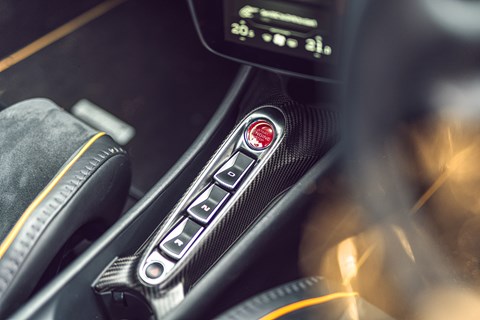
They might not be direct rivals in price and performance but both cars have so much in common, it would be rude not to bring them together to compare and contrast. Both use a 3.0-litre V6 with twin turbos packaged within their widely-splayed (120°) cylinder banks. Both can rev to 8500rpm, while eight-speed dual-clutch transmissions containing an axial-flux e-motor as well as actual gear ratios are directly comparable, as are 7.4kWh batteries that boost performance and let both cruise emissions-free at a little over 80mph.
Nine years since Ferrari and McLaren blooded the hybrid hypercar with the LaFerrari and P1, the Artura and 296 take plug-in hybrid technology to the core line-up. The way they make you feel while delivering that technology, though, is fascinatingly different.
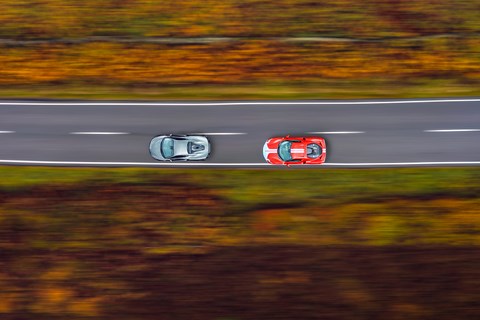
Earlier that morning I headed north from the East Midlands in the McLaren, creeping off silently at 6.30am with the battery fully charged like a cat burglar tip-toeing through a bedroom. So much is new here: not just the entire powertrain, but the MCLA carbonfibre tub designed to help package it (helping the McLaren weigh 1498kg with fluids, only 46kg heavier than the non-hybrid 570S and some 75kg lighter than the aluminium Ferrari), new electrical architecture, vastly improved new infotainment, and new powertrain and chassis controls grouped on two cheap-feeling pods hidden behind the steering wheel.
And yet the Artura still exudes McLaren-ness, from a design that tones the puppy fat from a 570S to a seating position that sets you low in a decluttered and highly focused cabin with familiar switchgear. There’s a noticeably soft brake pedal served to your left foot, the scuttle is low and visibility excellent, even if I do want to raise the steering wheel a fraction and drop my shoulders slightly back.
Select Hybrid mode and the M630 V6 will at some point erupt, the transition sometimes smooth, sometimes a little lumpy. The soundtrack is more gruff industrial techno than musical, but it does lend real gravitas to a car that prioritises grit over showy flim-flam. It sounds closely-related to the old V8, but response is in another league – the 3000rpm-plus lag that defined all previous ‘new-era’ McLarens is drastically reduced, the mid-range shove way stronger. It feels ‘on’ in a way the brilliant 570S simply doesn’t, and my God there’s real fury bottled up here.
I’m threading cross-country on quiet roads, sun late to peek through the gloom. While occasionally the ride bobbles over poor surfaces, Comfort retains the pliancy and control that always defines McLarens and syncs so beautifully with hydraulically-assisted steering, another (near) USP. It might not be the very best McLaren helm but the analogue clarity of its feedback is still stand-out special. The thickness and firmness of the alcantara rim, the consistency lock-to-lock, that analogue detail – it all builds confidence in these foul conditions as I climb higher into the Peaks.
Artura meets 296
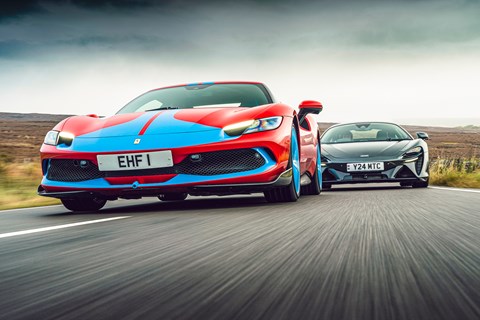
James Dennison is waiting in the 296 GTB when I arrive, its loud paintwork and interior a homage to racecars run by Maranello Concessionaires in the UK from the ’60s. This one has the Assetto Fiorano package, a track-focused option with uprated springs and non-adjustable dampers plus lightweight extras including a polycarbonate engine cover and carbonfibre interior door casings.
There’s a lot going on inside, and I’m not just talking about the baby blue seats. ‘There’s not enough lumbar support,’ notes JD, ‘even if the driving position is nice and low.’ Get comfortable and you must still get your head around the digital instruments, capacitive switches on the steering wheel for powertrain settings (everything from pure EV to a Qualifying mode to charge the battery) and a manettino irritatingly no longer labelled with drive modes. JT later notes too much eyes-off-the-road time trying to operate key functions, and JD dislikes the removal of a physical start button.
Straight off the bat the Ferrari has a clarity of response to make the McLaren feel a little mushy. It’s in everything, from the tightly drawn brake-by-wire pedal (impressive given it also triggers some re-gen, unlike the McLaren) to the shorter travel of the paddles, the snap of the gearshifts and steering that’s super-fast and clinically accurate. ‘Direction changes are phenomenal,’ notes JD, ‘almost like it has rear-wheel steering; you flick your wrists and it’s not just the front, it’s like the whole thing rotates.’
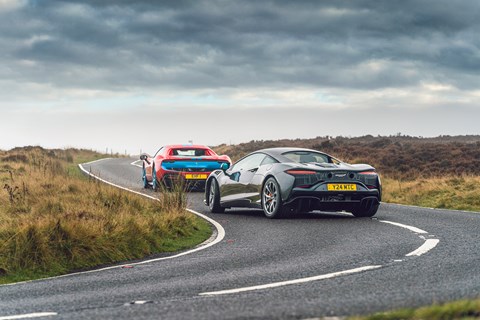
The Ferrari might be light on its toes but it’s not intimately keyed into this wet surface, provoking hesitancy, and on these optional fixed dampers it’s far more surface-dependent than the McLaren – often perfectly liveable on main roads, it becomes unpleasantly lumpy on smaller routes. Somehow, despite the tape measure saying otherwise, the Ferrari feels significantly wider, another barrier to letting it off the leash on these narrow roads lined with crumbly dry-stone walls. JD cautions not to judge it too harshly here, reminding me how epic it felt in the expanses of North Wales in CAR’s 2022 Sports Car Giant Test.
As conditions become merely damp, it starts to come alive, combining those lightning reactions with the grip and balance to let you take big bites, not just nervous nibbles. It attacks one hairpin-littered uphill section like a razor slashing it to ribbons. It’s also surprisingly adept at getting its prodigious power down, software and hardware working seamlessly. This is more like it.
Track time
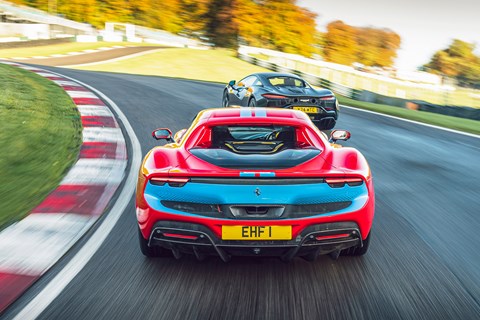
We head over to Cadwell in the darkness, ready to lap the track first thing next day. I continue to bond with the Ferrari on the smooth, wide roads that flow over the landscape. Its damping is happier and there’s space – briefly – to really lean on the outrageous performance.
This powertrain is phenomenal, fizzing with a kind of naturally aspirated-plus energy that responds to your right foot instantaneously, then morphs from a muscular mid-range to a soaring 8500rpm climax that’s both unbridled in its ferocity and carefully drip-fed in its linearity. The noise is far more multi-faceted than the McLaren’s, with hints of mournful V6 timbre, turbo exhalations that could soundtrack a Star Wars dogfight, brassy parps, and downright brutal performance that even shades Ferrari’s flat-plane crank V8. No question it’s a Ferrari engine, or that it makes downsizing an upgrade.
Then it just slips through the Cadwell pits in e-mode like butter wouldn’t melt. Moi? Cadwell’s a fabulous place, a thin strip of tarmac laced over tumbling, manicured landscape like a scaled-up model railway. Frequently unsighted, economical on run-off, terrifyingly fast in places, the 2.25-mile loop is not for newbies.
Everything that worked against the Ferrari yesterday and made it feel edgy starts to flip in its favour here once yesterday’s damp dries. It is scalpel-sharp, the closest thing on four wheels to those onboard F-16 YouTube videos where the pilot seems to tilt the world on its axis. It is so malleable, so responsive that the 296 just goes where you point it, no matter what physics has on today’s agenda.
A wheelbase 50mm shorter than the F8 helps it flick through the slower stuff under the trees, and while you do need quicker reflexes to catch it if it grips up mid-powerslide than the F8 Tributo, there’s an unreal balance of reactivity and stability through the fast corners out the back. The electric power steering is super-pointy, if more synthetic than the McLaren’s, and the brakes mighty. You can go really deep and lean on the front end, while the diff aggressively locks up, encouraging you to tweak the nose tighter. For a car that can be so flamboyant, it’s startling how much performance it’ll let you rip into as you power through a fast corner.
James Taylor has raced here, sees more than 150mph on both straights, reports feeling the aero work his neck through the quick stuff in a way the McLaren didn’t, marvels at the Ferrari’s extra lateral grip and notes that while the steering is very different to the Artura’s, he likes it no less. He also nails it when he says, ‘I’d prefer to drive the Ferrari here, but I’d take the McLaren if I were learning the place.’
The McLaren’s performance is easily shaded by the Ferrari but in any other context the Artura would feel, and is, indecently rapid. I really click with it at Cadwell, especially when I back off the damping to Sport and let it breathe a little more.
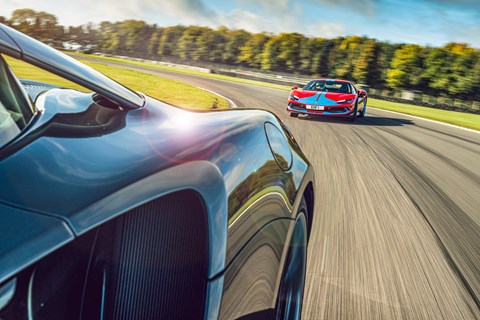
It doesn’t do the razor-sharp thing like the Ferrari, but it certainly multi-tasks through the slower flicks, soaking up kerbs, staying flat and composed and encouraging you to work that gorgeously detailed steering hard to get the weight transfer helping with direction changes. With its new e-diff, it’s also very happy to be smeared sideways and is more forgiving than the Ferrari when it grips up.
Everyone mentions the extra understeer in the McLaren, particularly in quicker corners, but the 570S was similar and it’s part of an interactive balance that I enjoy manipulating. You lean on a little bit of that slip to feel the limit, briefly back off the throttle to help ease the rear round, then flatten it again to power out gathering speed rapidly with just a little oversteer. It’s interactive, communicative and beautifully balanced, as well as more planted than a 570S.
There’s no doubting the Ferrari is the sharper track tool, however. JD succinctly likens the McLaren’s overall feel to a softer ‘wet’ race set-up in comparison to the Ferrari’s ultra-responsive ‘dry’ spec, noting the slower steering has a dead-zone around the centre when committing to a corner that requires extra lock where the Ferrari just scythes at the apex. And yet as the day winds down we keep coming back to how useable and approachable the McLaren is. Everyone wants another go.
Despite the step-change in technology, the McLaren feels a gentler evolution of the 570S formula. That’s not damning it with faint praise because we all think it’s a superb car. We’d all take it to live with every day and in all conditions and, given its greater affordability, that might sound ideal to a large number of you.
Hard as it is to fathom, the Ferrari takes a more pronounced step compared with the already outstanding F8 Tributo, from the zap of its powertrain to the reactivity and outright capability of its chassis. It performs at a higher level than the McLaren for outright excitement and capability, and while the Assetto Fiorano package is both a contributor to that and one reason for its less rounded road manners, the Ferrari wins a test in which its significantly less expensive and powerful rival comes very highly commended.